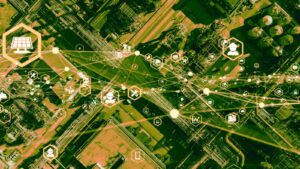Recycling and Sorting: From Futility to Efficiency
The last five years have seen unprecedented enthusiasm for recycling in the private and public sphere. Many companies, such as Coca-Cola (the worst global plastic polluter producing over 2.9 million tons of plastic packaging annually) have committed to collect and recycle a bottle (or can) for every one sold in the US by 2030. Building materials giant Lafarge Holcim has pledged to reuse and recycle 100 million tons of Construction and Demolition Waste (CDW) by 2030. Conversely, there is also an increased demand for high-quality recycled plastic as Fast Moving Consumer Goods (FMCG) companies seek to meet consumer demand. It is estimated the market for recycled plastic will grow to $66.7 billion by 2025, at a CAGR of 6.8%.
Due to the unmanageable influx of contaminated bails of ‘recyclable waste,’ the export of recyclables to mostly Southeast Asian countries has been restricted to all but the cleanest of wastes. This has been enforced via regulation, particularly China’s 2018 export ban. In December 2020, the EU banned the export of dirty plastic waste to non-OECD countries. As a result, governments and the recycling industry are seeking to:
- Ensure top quality recycling bails
- Explore alternative supply chains
- Invest in domestic solutions.
However, it is estimated that the US still exports 1 million tons of plastic waste annually to countries who mismanage up to 70% of their own waste. It is also estimates that 20% – 70% of plastic entering any recycling facilities is discarded. This results in more waste going to landfilled or, in many cases, being burnt under the guise of recycling. Innovation needs to move rapidly down the cost curve to bolster the market for domestic material recovery facilities and to discourage inefficient exports to countries with cheaper labor.
The increase in recyclable waste and demand for quality recycled commodities combined with the need to discourage exports means that Material Recovery Facility efficiency is becoming increasingly important. This insight assesses the technologies and seeks to address compounding challenges such as automated sorting technologies and associated data platforms.
Material Recovery Facilities
Material Recovery Facilities (MRF) are where centralized sorting and processing of recyclables take place in order to get materials ready for sale on commodity markets. Materials in smaller MRFs are usually manually sorted, while larger MRFs use disk screens to complete sorting. MRFs are usually managed by risk-adverse and budget-tight local authorities which face many challenges, including:
- Growth and diversification of waste collection
- High contamination (e.g., non-recyclables) causes jams and downtime of machinery resulting in delays.
- Sorting plastics by polymer type which requires extra time and capacity.
- High costs of running and staffing MRFs (current estimate for sorting labor in the US is $5 billion)
- A lack of tools to estimate waste composition (so its value is downgraded).
Attractiveness
The global waste sorting equipment market is estimated to reach $1.84 billion by 2027, growing at a CAGR of 12.4%. While the wider recycling market is estimated to hit $530 billion by 2025.
Extended Producer Responsibility (EPR) regulations, mounting export scandals and consumer and market pressure continue to drive corporates, especially fast-moving consumer goods (FMCGs) companies, to showcase their efforts to recycle.
Autonomous optical and waste sorting systems have been a success story in the recycling industry. Key players ZenRobotics and AMP Robotics have dozens of installations in place on a commercial scale. Systems are largely material agnostic; however some specializations are necessary, for example, with heavy C&D waste.
Business Models
Commercial economies of scale and cheaper underpinning technologies-including sensors, cameras and robotics- are moving systems down the cost-curve and reducing the CapEx for customers. However, autonomous and optical sorting systems are still considered expensive and so use is confined to larger MRFs. Innovators are therefore offering as-a-service or leasing business models to reduce the risk to the customer.
Cleantech group spoke to Chris Wirth, Vice President of Marketing at AMP Robotics , who explained, “Our systems are modular, plug and play for retrofitting. We have also recently introduced a leasing model, which not only lowers the capital outlay but steadies the variable cost of sorting, hedges and creates a fixed cost for customers. In the future, we are looking at subscription-based models to account for the continuing innovation of our products.” In January 2021, AMP Robotics raised $55 million in a Series B round led by XN Ventures with participation from investors including Valor Equity Partners, Closed Loop Partners and previous investor Sequoia Capital. The company intends to use the funds to scale up, meet market demand and develop new AI product applications.
Earlier stage optical sensor and AI developer, Recycleye pivoted from sensors for smart bin applications to partnering with a robotics firms to offer automated sorting to MRFs. Cleantech Group spoke to Victor Dewulf, CEO of Recycleye, who explained, “We reoriented away from smart bins as they are too expensive for the customer and you can only sort into four classes. We are now working to get the cost of sorting at MRFs down to zero. We are also working towards dynamic pricing; our software links with market pricing so you can align this with purity”. In December 2020, Recycleye raised $1.6 million in a seed round for continued development of its computer vision system and for continued company expansion.
Similar innovators who received funding in the last 18 months include:
- May 2020: Greyparrot, provider of computer vision solutions to power next generation robotics and smart systems for waste management, raised $2.2 million in a seed round from investors Speedinvest and Force Over Mass.
- May 2020: Everest Labs, developer of waste sorting robotics and optical sensor solutions for MRFs, raised an undisclosed amount in a seed round with investors Xplorer Capital, Sierra Ventures and Morado Ventures.
- August 2019: Blue Green Vision, developer of optical sorting system for recyclable plastic, received seed funding from Sky Ocean Ventures and Innovate UK’s £6 million ($8.23 million) joint funding commitment in the global battle against plastic pollution.
Competition
MRFs and large waste management corporates are partnering with each other and innovators to develop and commercialize optical sorting and robotic solutions.
In October 2018, following a partnership with Bulk Handling Systems and Veolia’s 200 strong R&D Artificial Intelligence department, the Max AI robotic sorting system became the first of its kind to be operational in Europe. In December 2020, developer of waste processing machinery Machinex announced it was installing it’s first sorting robots in Europe at Veolia in France.
In July 2019, waste giant SUEZ opened “Europe’s most advanced packaging sorting facility for lightweight packaging,‘” which uses an optical sorting system to sort up to 14 different types of material and 9 types of plastics. This was in response to 2019 German regulation mandating 50% lightweight packaging and 58.5% plastics recovery rate.
The inefficiencies at MRF’s are so great that many innovators have taken a collaborative approach to establish a thriving recycling market based on data. Recycleye has partnered with universities, including Imperial College London, to create the open-source database WasteNet , the largest dataset for waste, which holds over 2.5 million training images created from optical sorters and deep learning. Victor Dewulf, CEO of Recyleye explained, “We open-source research to move the whole industry forward. The big players also need to open-source, otherwise transparency will be lost and development will be far slower.”
It is clear automated sorting and optical sensors can address many inefficiencies at MRFs. However, significant investment is still needed to scale these technologies for both large MRFs as well as smaller, decentralized ones. As waste producers like FMCGs companies expand their recycling programs, they must also invest in domestic recovery infrastructure to avoid waste exports and ensure closed-loop recycling.
Look out for…
There are many other technologies seeking to digitize, automate and streamline processes at MRFs and, ultimately, create a quality market for recyclables. For example, MerQbiz has developed a sensors and software solution to provide insights on the value of paper bales as a solution to improve quality and market confidence with paper recycling.
Another supporting technology is smart tags for packaging, where optical scanners at MRFs can recognize tags and sort to a higher level of granularity. For example, the HolyGrail 2.0 initiative is a FMCG consortium (co-ordinated by the Ellen MacArthur Foundation) which is seeking to test the viability of digital watermarks on packaging. In September 2020, packaging corporate Mondi began the first digital water mark trial with innovator Digimarc.
All these technologies are using data to underpin a quality market for recyclable materials, while reducing the costs of processing to well below the value of recovered materials. The greater aim is to transform the waste market to view recyclables as commodities with value and not as waste.


